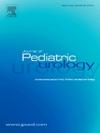典型膀胱外翻患者的终末期肾病和慢性肾病:一项跨机构队列回顾性研究。
IF 2
3区 医学
Q2 PEDIATRICS
引用次数: 0
摘要
导言:虽然大多数典型膀胱外翻(CBE)患儿出生时肾脏正常,但有些患儿成年后肾功能会恶化。人们对这一人群中终末期肾病和慢性肾病(分别为 ESKD 和 CKD)的发病率知之甚少。我们小组最近发表了一篇关于 216 名 CBE 患者的多机构队列手术结果的文章。我们的目的是描述这一 CBE 患者队列中 ESKD 的发病率和 CKD 的患病率:我们回顾性地查看了前述五个三级医疗中心的 CBE 患者的随访记录。主要结果是ESKD的发生率,ESKD的定义是永久性腹膜透析/血液透析或肾移植。次要结果是最后一次就诊时 CKD 3 期或更高(CKD3+,估计肾小球滤过率 [eGFR]2)的患病率。以肌酐为基础的 eGFR 采用 CKD-EPI 肌酐方程(成人)和 Schwartz 公式(儿童)计算。采用生存分析和费雪精确检验:共有 201 名患者(占原始队列的 93%)提供了肾功能数据(63% 为男性)。四名进行了原发性尿路改道的患者在中位随访 20.1 年后仍未改道。其中无一人发展为 ESKD,一人发展为 CKD3+。其余 197 名患者接受了原发性膀胱闭合术。在中位 18.8 年的随访中,12 名患者进行了膀胱改道,108 名患者进行了膀胱扩容,77 名患者既没有进行膀胱扩容也没有进行膀胱改道。3 名患者(1.5%)在中位 23.4 岁时出现 ESKD(1 例血液透析,2 例移植)。根据生存分析,10 年内发生 ESKD 的风险为 0%,20 年内为 1%,30 年内为 5%(图 1)。这高于普通人群 21 岁时的 0.003% 的风险(P 结论):CBE 患者罹患 ESKD 和 CKD 的风险并非微不足道,而且似乎比普通人群更为常见。膀胱出口阻力增加等可改变的致病因素的潜在作用值得进一步研究。需要对这类人群进行可靠的长期随访,以监测 ESKD 和 CKD。本文章由计算机程序翻译,如有差异,请以英文原文为准。
End-stage and chronic kidney disease in classic bladder exstrophy: A retrospective muti-institutional cohort study
Introduction
While most children with classic bladder exstrophy (CBE) are born with normal kidneys, some experience renal deterioration in adulthood. Little is known about the incidence of end-stage and chronic kidney disease (ESKD and CKD, respectively) in this population. Our group has recently published on surgical outcomes in a multi-institutional cohort of 216 people with CBE. Our aim was to describe the incidence of ESKD and prevalence of CKD in this cohort of people with CBE.
Methods
We retrospectively reviewed records of patients with CBE followed at five tertiary care centers described previously. The primary outcome was incidence of ESKD, defined as permanent peritoneal/hemodialysis or renal transplantation. The secondary outcome was prevalence of CKD stage 3 or higher (CKD3+, estimated glomerular filtration rate [eGFR]<60 ml/min/1.73 m2) at the last appointment. Creatinine-based eGFRs were calculated using the CKD-EPI Creatinine Equation (adults) and the Schwartz formula (children). Survival analysis and Fisher's exact test were used.
Results
A total of 201 patients (93 % of the original cohort) had renal function data available (63 % male). Four patients who had a primary urinary diversion remained diverted at a median follow-up of 20.1 years. None developed ESKD and one developed CKD3+. The remaining 197 patients had a primary bladder closure. At a median follow-up of 18.8 years old, 12 were diverted, 108 were augmented and 77 were neither. Three patients developed ESKD (1.5 %) at a median age of 23.4 years (1 hemodialysis, 2 transplantation). On survival analysis, the risk of ESKD was 0 % at 10 years, 1 % at 20 years and 5 % at 30 years (Figure 1). This was higher than the risk of 0.003 % at 21 years of age in the general population (p < 0.001). The median age of 141 individuals with eGFR data was 21.6 years old (65 % male). No children, 4 % of adolescents and 8 % of adults had CKD3+ (p = 0.45). On exploratory analyses, prevalence of CKD3+ did not differ by center or birth year (p ≥ 0.99).
Conclusions
The risk of ESKD and CKD among patients with CBE is not insignificant and appears to be more common than the general population. The potential role of modifiable contributing factors, such as increased bladder outlet resistance, warrants further investigation. Reliable long-term follow up is needed in this population to monitor for ESKD and CKD.
求助全文
通过发布文献求助,成功后即可免费获取论文全文。
去求助
来源期刊

Journal of Pediatric Urology
PEDIATRICS-UROLOGY & NEPHROLOGY
CiteScore
3.70
自引率
15.00%
发文量
330
审稿时长
4-8 weeks
期刊介绍:
The Journal of Pediatric Urology publishes submitted research and clinical articles relating to Pediatric Urology which have been accepted after adequate peer review.
It publishes regular articles that have been submitted after invitation, that cover the curriculum of Pediatric Urology, and enable trainee surgeons to attain theoretical competence of the sub-specialty.
It publishes regular reviews of pediatric urological articles appearing in other journals.
It publishes invited review articles by recognised experts on modern or controversial aspects of the sub-specialty.
It enables any affiliated society to advertise society events or information in the journal without charge and will publish abstracts of papers to be read at society meetings.
 求助内容:
求助内容: 应助结果提醒方式:
应助结果提醒方式:


